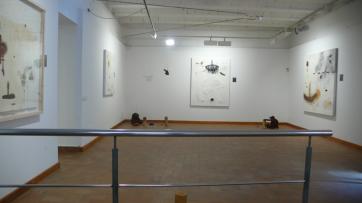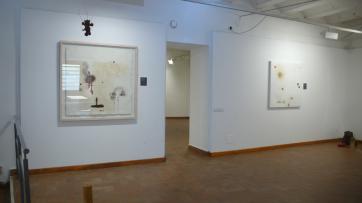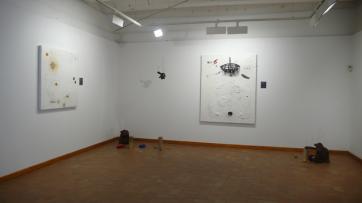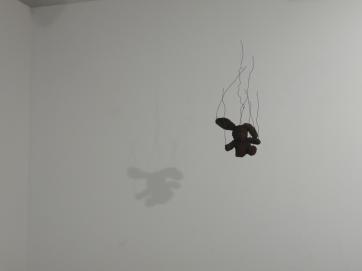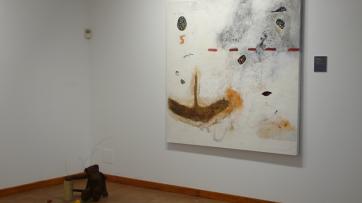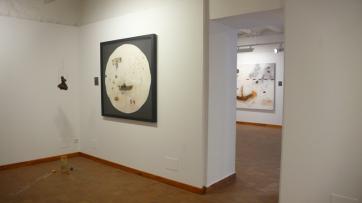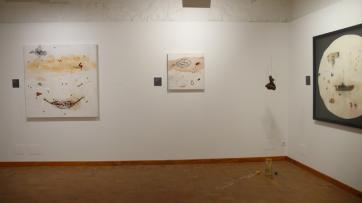<< Other exhibitions
Individual exhibitions
 Exhibition catalog. Texts by Carme Bergés. Directora del Museo de Cervera and Ricard Planas, director de la revista Bonart and crítico de arte (PDF 3.246,24 Kb)
Exhibition catalog. Texts by Carme Bergés. Directora del Museo de Cervera and Ricard Planas, director de la revista Bonart and crítico de arte (PDF 3.246,24 Kb)2011
Del llibre de l'aigua : Com a titelles
MUSEU COMARCAL DE L'URGELL.
Organization : Xarxa de Museus de Lleida i Aran
LITERARY CRITIQUES
PRESENTATION
An initiative of the museums of Lleida and a creative proposal by Joanpere Massana
Carme Bergés Saura
Les Terres de Lleida i Aran Museum Network
The initiative
About a year ago we presented the Strategic Plan for the Les Terres de Lleida i Aran Museum Network, which established the guidelines under which a series of museums was to work; museums that, although diverse in terms of structure, content and scope, are united by the same desire to live in and for a particular region.
On the one hand we are fully aware, as shown by the work undertaken by each of the museums in the network, of the need to conserve, study and make known our existing heritage. On the other, however, we wanted to go a little further, not only in the design of new, more attractive activities that involve teamwork, but also in the extent of our responsibilities.
We wished to build new bridges between museums, understood to be experts in watching over heritage, and the creators that live and work in Catalonia, here with a twofold meaning—in the universal sense—and as representatives and/or ambassadors of their common land.
It was in this context that the initiative we present here arose. With the exhibition of work by Ponts artist Joanpere Massana, we are starting a cycle that, over the years, is to make the halls of the Network museums a stage and platform for current artistic proposals, with the firm aim of becoming a means of supporting and promoting our local creators.
The proposal
‘Del llibre de l’aigua: com a titelles’, by Joanpere Massana
Observing the work of Joanpere Massana I was suddenly reminded of two words that can be simply stated but have a wealth of meaning: journey—as an internal reconnaissance by the artist, and sensitive and emotional for the spectator—and geography, or rather geographies—built on recognised physical elements to show us internal portraits that reflect us.
It may sound strange, but that is how I have chosen to define this painted book: as an invitation to join the artist on his journey, which will also be ours, and which will take us from childhood—his, but also the first age of man—to old age via a series of geographies—physical and sensitive—which are very personal, but also universal.
The game Joanpere Massana proposes suddenly becomes evident. There’s no one without the other, no black if not on white, there’s no calm without a storm, no voyage without a port, no movement without a halt… and we could go on like this until we’ve discovered each and every one of the works in this edition of ‘The Book of Water’. As time, or water, goes by, it contrasts with the permanence of things or the ship’s anchor. Contrasted with the soft white plush that defines the naïveté of childhood is hard cold steel, which defines the passage of time and the loss of longed-for innocence. Alongside the concept of voyage-ship (positive movement) is the anchor (prejudice, entrenched values that hold us back...?). Contrasting with the peaceful flow of the water or the floating pebble taking shape is the heavy stone that sinks and leaves its mark. Alongside discovery and curiosity is certainty.
In short, a series of icons that constitute a veritable intellectual dictionary that the artist plays with in order to define a universe in constant dialogue.
This ‘Del llibre de l’aigua: com a titelles’ [From the Book of Water: Like Puppets] is the final chapter of a book that has formed, growing and rewriting itself, since 2007 when the first part appeared in Naples with the generic Italian title ‘Il libro dell’acqua’. Joanpere Massana thus closes another cycle in his, what we could term bibliophilic career (and I quote, in this case faithfully, the dictionary entry: special edition due to certain features of rarity, binding, illustration, etc.). ‘El llibre de l’aigua’ (in its various editions from 2007 to 2011), ‘El llibre dels arbres’ [The Book of Trees], 2006; ‘Lo llibre dels núvols’, [The Book of Clouds], 2004; ‘Un llibre per la Jana’, [A Book for Jana],2003; and ‘Lo llibre dels jocs’, [The Book of Games], 2002, are his own private editions painstakingly worked in the finest detail, such as the simulation of bindings, the types of paper and format used in perfect symbiosis with the work itself.
Furthermore, as can be seen from his artistic and professional work, Joanpere Massana is an expert in artistic languages that, throughout our most recent history, have translated the concerns and needs of a society in a constant state of movement and transformation.
Abstract expressionism, of a more symbolic nature than the visceral intensity of the original movement, seems to drive his work, which yet imbibes from other learned concepts. From a conceptualism that advocates (extols the virtues of) the reflexive activity that can and should bring about the artistic object, to the importance of the transformation process, of the handling of materials to achieve new constructions that define poor art or the new behaviour resulting from more recent movements that propose a review of the more traditional notion of artistic space where the desacralising action of the collage or the most varied forms of current artistic installations and interventions are registered.
To all this we must add a look of his own, which has created a personal language that combines, without us realising, shapes of great lyricism with forceful elements. Once again, what we described earlier on: the poetry and intimism—subtle shapes, soft colours, suggestive lines—contrast with hardness—clear, isolated icons that command the space, dark colours, textured elements.
The appeal of the work that makes up this book and, therefore, of Joanpere Massana’s personal language, lies in a sage and subtle mixture of technique and concept. Paper is the perfect medium for the external elements—resin, clay, thread, crystals—but not the only one, since Massana also works on wood and canvas, at the same time building new sets that invade the museum space in installations with a strong, bittersweet poetic content. The creation of archetypes is also a virtually omnipresent constant in this artist’s work—the anchor, the root, the number, plush, the house: an attempt to encompass everything in iconographs full of meaning that remind us of our ties (cultural, family, emotional) and our longing to sail uncharted seas in tenacious search.
We trust that this journey that we begin today with ‘Del llibre de l’aigua’ by Joanpere Massana becomes a milestone, important but not the only one on this long and worthwhile quest through the artistic proposals of our contemporary creators.
A journey, after all, neither begins in the instant we set out, nor ends when we have reached our door step
once again. It starts much earlier and is really never over, because
the film of memory continues running on
inside of us long after we have come to a physical standstill...
Travel is his vital exertion, his self-justification is the delving into, the struggle to learn - about life, the world, perhaps ultimately oneself.
Ryszard Kapuscinski, Travels with Herodotus





